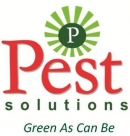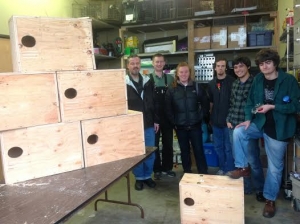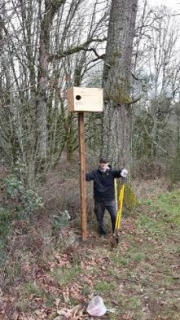Skeptics abound -- but so do owl boxes
Eric Ufer, April 2 2014
 Pest control -- is it a necessity or an environmental hornet's nest? If you are like most people I meet, you don’t want sugar ants overrunning your pantry or molehills pock-marking your yard. But you probably also mistrust the chemicals and high costs that can go with the trade.
Pest control -- is it a necessity or an environmental hornet's nest? If you are like most people I meet, you don’t want sugar ants overrunning your pantry or molehills pock-marking your yard. But you probably also mistrust the chemicals and high costs that can go with the trade.
Three years ago, I was right there with you. A burned-out stockbroker managing several rental properties with my wife, I was deeply frustrated with how little we knew about what was being sprayed in our tenants’ apartments each and every month, often at great cost and to no avail. My competitive juices kicked in, and I decided to start Pest Solutions LLC -- a company that would exist to protect people and properties WHILE being “Green As Can Be” (our slogan!).
From flushing floor drains in order to reduce restaurant fruit flies, to using more baits and less airborne sprays, we've had success with greener techniques -- enough so that we’ve become the official pest control for Providence Park (formerly Jeld-Wen Field) and the Portland Timbers.
And we love to expand our circle of green-minded entrepreneurs. But the feeling isn’t always mutual, as mistrust of my new profession, well, dies hard.
 Two weeks ago, I attended The Intertwine Spring Summit, encouraged by Metro’s Michelle DePass following a conversation about bringing creative approaches and solutions to our clients. I knew that I’d probably be viewed a bit skeptically, and I was right. The good news was that I did have the opportunity to explain that greening pest control is a work in progress -- a message that seemed to resonate with most folks at the conference. What better way to get “greener” than exchanging ideas with passionate experts like those in The Intertwine Alliance?
Two weeks ago, I attended The Intertwine Spring Summit, encouraged by Metro’s Michelle DePass following a conversation about bringing creative approaches and solutions to our clients. I knew that I’d probably be viewed a bit skeptically, and I was right. The good news was that I did have the opportunity to explain that greening pest control is a work in progress -- a message that seemed to resonate with most folks at the conference. What better way to get “greener” than exchanging ideas with passionate experts like those in The Intertwine Alliance?
 An example of the direction we’re going -- one that’s drawn a lot of attention from folks here -- is the owl box. This nature-based solution came to us through Richard, a teammate who previously worked in R&D for Oregon State University.
An example of the direction we’re going -- one that’s drawn a lot of attention from folks here -- is the owl box. This nature-based solution came to us through Richard, a teammate who previously worked in R&D for Oregon State University.
Early on with us, Richard explained how he had used owl boxes successfully to help keep rodents under control in OSU’s own R&D fields. Owls are expert natural rodent control agents. It is estimated that a barn owl can consume a third of its body weight per night -- which is about six rodents.
 The owl box isn’t for those seeking a quick fix to rodent control. It’s a long-term solution -- one that's effective, affordable, and green. And it’s caught on; we’re installing them in parks, cities, schools, even correctional facilities.
The owl box isn’t for those seeking a quick fix to rodent control. It’s a long-term solution -- one that's effective, affordable, and green. And it’s caught on; we’re installing them in parks, cities, schools, even correctional facilities.
Our client Chad Naugle, the Head of Sustainability at the Oregon Department of Corrections, points to another reason owl boxes are going over big with government agencies.
“They’re helping us reduce toxins per the Governor’s Green Chemistry Executive Order 12-05,” Chad told us recently.
My business is just one of many that’s actively seeking greener, cost-effective ways to solve practical issues (I have yet to find anyone arguing for peaceful coexistence with bed bugs). Have you got an idea like Richard’s? Let’s talk!

 Eric Ufer is the Founder of
Eric Ufer is the Founder of
Add new comment